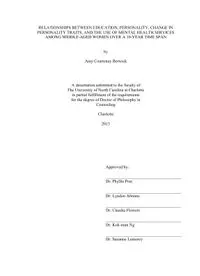
relationships between education, personality, change in personality traits, and the use of mental PDF
Preview relationships between education, personality, change in personality traits, and the use of mental
RELATIONSHIPS BETWEEN EDUCATION, PERSONALITY, CHANGE IN PERSONALITY TRAITS, AND THE USE OF MENTAL HEALTH SERVICES AMONG MIDDLE-AGED WOMEN OVER A 10-YEAR TIME SPAN by Amy Courtenay Berwick A dissertation submitted to the faculty of The University of North Carolina at Charlotte in partial fulfillment of the requirements for the degree of Doctor of Philosophy in Counseling Charlotte 2013 Approved by: ____________________________________ Dr. Phyllis Post ____________________________________ Dr. Lyndon Abrams ____________________________________ Dr. Claudia Flowers ____________________________________ Dr. Kok-mun Ng ____________________________________ Dr. Suzanne Lamorey ii © 2013 Amy Courtenay Berwick ALL RIGHTS RESERVED iii ABSTRACT AMY C. BERWICK. Relationship between education, personality traits, change in personality traits, and the use of mental health services among middle-aged women over a 10-year time span. (Under the direction of DR. PHYLLIS POST) The purpose of this study was to examine the relationship between various levels of education, personality traits (neuroticism, extraversion, conscientiousness, agreeableness, and openness to experience), personality trait changes over time, and use of mental health services among middle-aged women. The subjects were 1110 women from 40 to 60 years of age responding to the 2005 National Survey of Midlife Development in the United States (MIDUS). The study used logistic regression first to investigate the predictive value of varying levels of education and personality traits on use of services during the past 12 months. A second logistic regression was used to investigate personality trait changes (between 1995 and 2005) on use of services during the past 12 months. Change scores were calculated using the reliable change index (RCI). In the first logistic regression, neuroticism (OR = 1.82, p <.001) and openness to experience (OR = 1.51, p < .05) were associated with significantly increased likelihood of mental health service utilization among middle-aged women. Conscientiousness (OR= 0.65, p < .05), in contrast, was associated with decreased likelihood of use of mental health services. Education and use of mental health services were not significant in the logistic regression. The second regression using the RCI scores was not significant, most likely due to the lack of reliable change for any of the personality traits. The significant association between neuroticism and conscientiousness and the use of mental health services among middle-aged women replicated findings from the 1995 MIDUS survey. iv However, this is the first study to find significance with openness to experience and use of mental health services among middle-aged women. Implications and future research are discussed. v ACKNOWLEDGEMENTS My special thanks go to my dissertation chair, Dr. Phyllis Post. Her assistance in organizing my thoughts and her guidance in developing my dissertation, were invaluable. The extraordinary amount of time she provided was amazing. My gratitude extends to my committee members, Dr. Lyndon Abrams, who always had time to listen; Dr. Kok-mun Ng, who pushed to make me be the best I could be; Dr. Claudia Flowers, without whom statistics would still be a mystery; and Dr. Suzanne Lamorey for joining from the outside to provide insight and expertise. Finally, I would like to express my sincerest appreciation to my entire committee for their extraordinary effort in the final push to get this project completed in time for a May graduation. None of this would have been possible without the support of my family and friends. To my son, Stirling, who inspires me with his love of life, to my father, Robert, who encourages me to set my goals high, and to my sister, Meredith, my best friend, we did it! I want to thank my incredible cohort for their encouragement and commiseration as we navigated this journey together. The bonds that we forged have made this process one of the most meaningful and rewarding experiences of my life. Finally, to Shenika Jones, from start to finish you have been with me, I cannot imagine this program without you. vi TABLE OF CONTENTS CHAPTER 1: INTRODUCTION .......................................................................................1 Overview ..........................................................................................................................1 Midlife..............................................................................................................................2 Mental Health and Underutilization of Services ..............................................................5 Education .........................................................................................................................7 Personality........................................................................................................................8 Purpose of the Study ......................................................................................................10 Significance of the Study ...............................................................................................10 Research .........................................................................................................................11 Questions ...........................................................................................................12 Design ................................................................................................................12 Delimitations .....................................................................................................13 Assumptions ......................................................................................................13 Limitations .........................................................................................................13 Validity ..........................................................................................................................14 Threats to Internal Validity ...............................................................................14 Threats to External Validity ..............................................................................15 Operational Definitions ..................................................................................................15 Midlife in the United States Study (MIDUS) ....................................................15 Middle-Aged Women ........................................................................................16 Education ...........................................................................................................16 Mental Health Service Utilization .....................................................................16 vii Personality Traits ...............................................................................................16 Summary ........................................................................................................................18 Organization of the Study ..............................................................................................18 CHAPTER 2: REVIEW OF THE LITERATURE ............................................................19 Introduction ....................................................................................................................19 Mental Health Services ..................................................................................................20 Empirical Research ............................................................................................21 Summary ...........................................................................................................24 Midlife............................................................................................................................25 Midlife Theories ................................................................................................26 Cohort Theory ..........................................................................................29 Role Enhancement Theory .......................................................................30 Midlife Mental Health .......................................................................................31 Summary ...........................................................................................................33 Education and Mental Health Services ..........................................................................34 Empirical Research ............................................................................................35 Summary ...........................................................................................................36 Personality......................................................................................................................37 Personality Theory .........................................................................................................38 Trait Theory .......................................................................................................40 Empirical Research ............................................................................................41 Personality and Gender ............................................................................42 Personality and Aging ..............................................................................43 viii Personality and Mental Health .................................................................44 Stability. ...................................................................................................47 Summary ...........................................................................................................50 Personality Traits ...........................................................................................................50 Neuroticism .......................................................................................................51 Stability ....................................................................................................51 Use of Services .........................................................................................53 Summary ..................................................................................................54 Extraversion .......................................................................................................55 Stability ....................................................................................................55 Use of Services .........................................................................................56 Summary ..................................................................................................57 Conscientiousness .............................................................................................58 Stability ....................................................................................................58 Use of Services .........................................................................................59 Summary ..................................................................................................59 Agreeableness ....................................................................................................59 Stability ....................................................................................................60 Use of Services .........................................................................................60 Summary ..................................................................................................60 Openness to Experience ....................................................................................61 ix Stability ....................................................................................................61 Use of services ..........................................................................................61 Summary ..................................................................................................62 Conclusion .....................................................................................................................63 CHAPTER 3: METHODOLOGY .....................................................................................65 Participants .....................................................................................................................65 Procedures ......................................................................................................................66 Instrumentation ..............................................................................................................66 Research Design.............................................................................................................70 Research Questions ........................................................................................................70 Data Analysis .................................................................................................................71 Summary ........................................................................................................................72 CHAPTER 4: RESULTS ...................................................................................................73 Description of Participants .............................................................................................73 Results of Research Question 1 .....................................................................................76 Results of Research Question 2 .....................................................................................78 Personality Trait Change Scores .......................................................................78 Logistic Regression ...........................................................................................79 Summary ........................................................................................................................80 CHAPTER 5: DISCUSSION .............................................................................................81 Overview ........................................................................................................................81 Discussion of the Results ...............................................................................................82 Demographics ....................................................................................................82 x Results of Research Question 1 .........................................................................83 Results of Research Question 2 .........................................................................87 Contribution of the Study...............................................................................................88 Implications of the Findings ..........................................................................................89 Limitations of the Study.................................................................................................90 Future Research .............................................................................................................92 Concluding Remarks ......................................................................................................93 REFERENCES ..................................................................................................................95 APPENDIX A: IRB EXEMPTION .................................................................................111 APPENDIX B: TERMS OF USE ....................................................................................112 APPENDIX C: MIDUS CODE BOOK ...........................................................................115 APPENDIX D: MIDUS SURVEY ..................................................................................121
